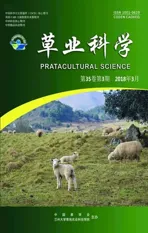AM真菌提高植物抗逆性的机制
2018-03-21张伟珍古丽君段廷玉草地农业生态系统国家重点实验室农业部草牧业创新重点实验室兰州大学草地农业科技学院甘肃兰州730020
张伟珍,古丽君,段廷玉(草地农业生态系统国家重点实验室 农业部草牧业创新重点实验室 兰州大学草地农业科技学院,甘肃 兰州 730020)
丛枝菌根(arbuscular mycorrhizae,AM)是由球囊菌门真菌(Glomeromycota)与陆生植物的根形成的一种共生体,在世界范围内分布十分广泛。90%的维管植物都能形成AM真菌,120余种AM真菌可以和超过200 000种植物共生[1]。AM真菌可以活化土壤中的无机营养元素,促进宿主植物对养分(如N、P、K、Zn等)的吸收[2-6],改善宿主的营养状况[7];促进水分代谢,增强植物抗旱性[8];提高宿主植物对低温、高温的耐受性[9-10];同时AM真菌亦可增强植物耐盐碱的能力[11],减轻土壤重金属污染对植物造成的危害[12];提高植物抗病性[13]、抗虫性[14],提高植物品质及其产量,对于植物适应各种逆境胁迫具有重要意义。
AM真菌在植物不同物种间的竞争中也有重要作用,可以引起群落的演替,促进物种多样性变化,影响生态系统的群落结构变化,促进系统中的碳循环及氮循环,从而在一定程度上影响全球气候的变化[15-17]。菌根生物技术的应用十分广泛,它在牧场草地修复、干旱地区土壤的改良、开垦荒山、植树造林以及保护自然生态资源、维持生态系统的稳定等方面均有重要作用[18]。AM真菌可以促进地表垃圾分解,抑制土壤微生物群落的生长,因此菌根生物技术也可广泛应用于环境修复,且这类技术具有适应性强的优点,即使在各种不利生态环境条件下,也能很好地应用,从而能更好地维持生态系统平衡[19-21]。因此加大对AM真菌的研究,尤其是利用AM真菌与植物共生对植物抗逆性的影响,对于实现农业可持续发展、促进生物多样性保护具有重要意义。
1 AM真菌对植物抗非生物逆境的抗性机制
1.1 抗旱
自然界诸多环境因子都会限制或影响植物进行正常生理生化代谢,水分是最普遍的胁迫因子之一[22-23]。水分缺失会导致植物叶面积减小,气孔关闭,根系呼吸作用加强,植株叶片光合速率和光合能力下降,严重时甚至造成植被大面积死亡;干旱地区土壤贫瘠,植被退化,生物多样性较少,生态系统稳定性降低,生态环境持续恶化,易遭受破坏且难以修复[24]。所以,提高植物体对干旱胁迫的耐受性可以促进植物群落多样性变化、维持生态系统结构和功能的稳定。
大量研究表明,AM真菌与植物体共生可以促进宿主植物对水分的吸收与利用,提高植物对干旱胁迫的抵抗能力[25]。近年来,国内外学者已对此进行了大量的试验验证。对紫花苜蓿(Medicagosativa)、三叶草(Trifoliumalexandrium)等多种植物[26-33]的研究结果表明,在干旱胁迫条件下,摩西球囊霉(Glomusmosseae)、根内球囊霉(G.intraradices)等AM真菌可以促进植物生长,提高植物抗旱能力。在对紫花苜蓿的研究中发现,当土壤相对含水量下降到20%时,接种摩西球囊霉的植株相比未接菌植株,其地上及地下部分的干物质产量平均可增加57.93和16.47 g,可溶性糖含量增加0.018%,可溶性蛋白含量增加0.004%,丙二醛含量降低0.007 μmol·g-1[26]。有关接种AM真菌对植物体内脯氨酸含量的影响仍存在很多争议,对民勤绢蒿(Seriphidiumminchünense)的研究发现,在水分胁迫下接种AM真菌的植株叶片脯氨酸含量低于未接菌植株[28],但在对连翘(Forsythiasuspensa)的研究中则发现,接种AM真菌显著增加了植株叶片脯氨酸含量[29]。AM真菌也可提高抗氧化酶类,包括超氧化物歧化酶(SOD)、过氧化物酶(POD)和过氧化氢酶(CAT)等的活性,在土壤相对含水量为30%的干旱胁迫条件下,以摩西球囊霉和缩球囊霉(G.constrictum)接种紫穗槐(Amorphafruticosa),其SOD活性较未接种AM真菌植株最高可增加6.61 U·(g·h)-1,POD活性最高增加189.61 μg·(g·min)-1,CAT活性最高增加49.38 U·(g·min)-1,而植株根系活力相应提高0.17 mg·(g·h)-1[33]。另外,AM真菌对植物的作用还包括促进土壤团聚体的形成,改善土壤理化性质;促进生长素合成,抑制胁迫响应因子脱落酸的合成等(表1)。
AM真菌提高植物抗旱性的作用机制可以归纳为生理生化机制和分子机制。AM真菌影响植物抗旱性主要表现在植物体自身产生的生理生化反应,包括提高可溶性糖、可溶性蛋白等渗透调节物质的积累,从而提高细胞液浓度,降低细胞渗透势,防止细胞脱水,细胞水势降低,与外界形成较高的水势差,提高细胞吸水或保水能力,从而适应水分胁迫环境[26];改变根系及叶片形态,降低叶片电解质透出率,增加气孔导度,提高根系导水性,增加叶绿素积累,促进植物光合作用[27];提高抗氧化酶类活性,增强宿主的活性氧(ROS)清除能力,降低H2O2的积累,减轻对原生质膜的伤害,保护生物膜的完整性,有效减轻干旱胁迫对植物的伤害[23,31];AM真菌可以分泌具有良好胶水性能的球囊霉素,有效增加土壤的渗透性及稳定性,而AM真菌菌丝则可以与土壤微粒结合,构建土壤团聚体的结构骨架,促进稳定性较高的土壤团聚体的形成,改善土壤理化性质,从而实现植物耐旱性能的提升[40];AM真菌菌丝网络构成了高效的营养物质吸收和转运系统,可以提高植物养分吸收效率,增强宿主植物的资源获取能力,促进植物营养代谢,从而促进水分吸收与利用,提高宿主抗旱性[41]。而究其本质,AM真菌提高植物抗旱性主要是通过上调或者下调胁迫应答基因表达,以及诱导新的抗逆基因表达等来实现的,如特异性调节水孔蛋白基因、编码脱水素的基因gmPIP2、gmlea8和gmlea10等相关基因的表达,其中水孔蛋白基因控制着水孔蛋白的合成,这种蛋白可以形成一个具有高度选择性的独立水通道,从而促进植物体水分的吸收与运输;而基因gmPIP2、gmlea8和gmlea10均可编码脱水素,这是植物体内的一种晚期胚胎富集蛋白(late embryogenesis-abundant proteins,LEA),具有很强的亲水性,可以维持细胞膜结构及功能的稳定,保护蛋白质和螯合金属离子,因此与植物响应干旱胁迫密切相关[30-32]。目前,有关AM真菌对植物干旱胁迫的影响及其抗性机制的研究主要集中于植物个体水平的生理生化层面,而对于菌根植物适应干旱胁迫的分子机制还缺乏系统深入的研究。

表1 AM真菌对干旱胁迫的响应及其机制Table 1 Response and mechanism of AM fungi to drought stress
续表1
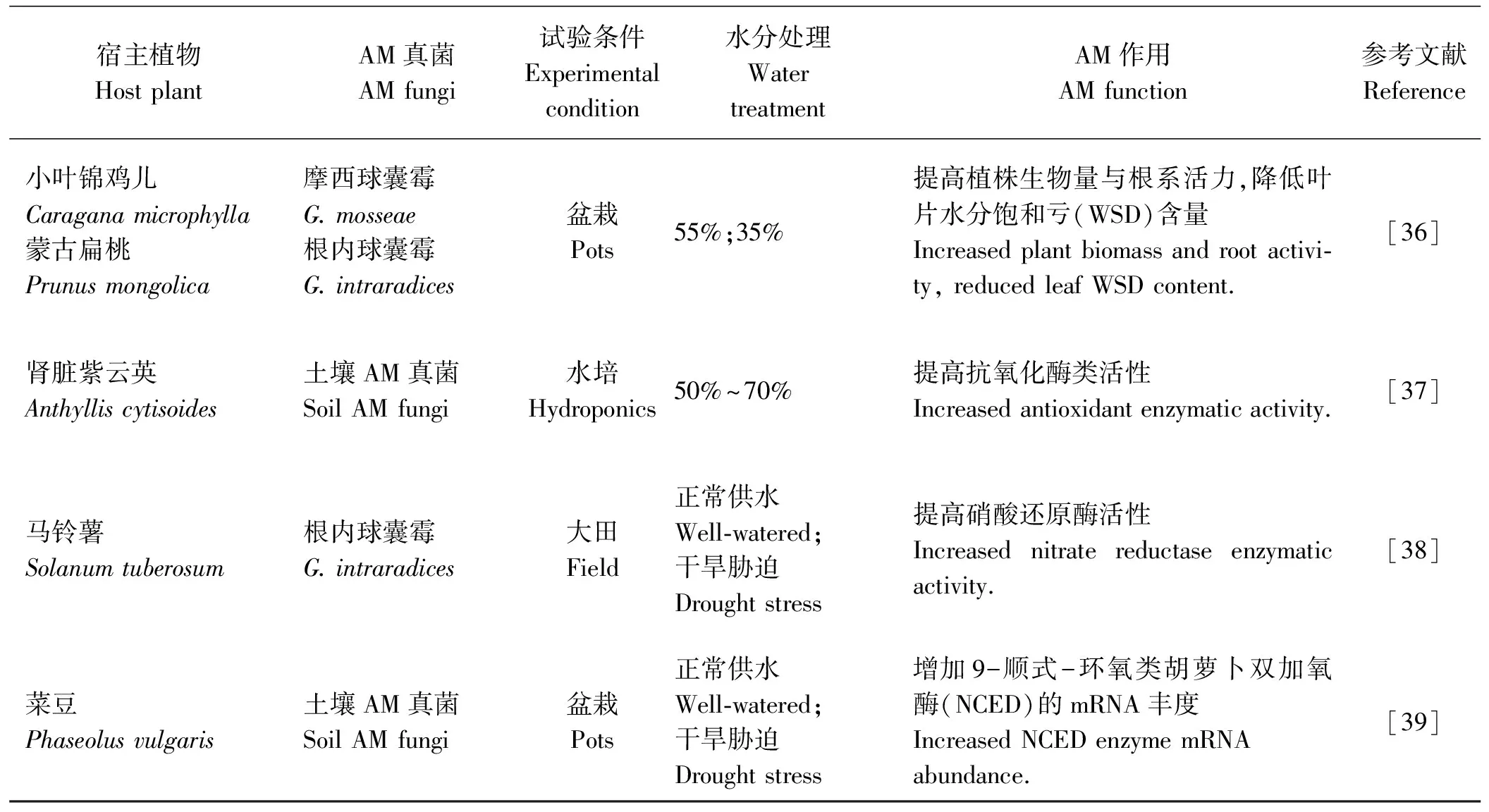
宿主植物HostplantAM真菌AMfungi试验条件Experimentalcondition水分处理WatertreatmentAM作用AMfunction参考文献Reference小叶锦鸡儿Caraganamicrophylla蒙古扁桃Prunusmongolica摩西球囊霉G.mosseae根内球囊霉G.intraradices盆栽Pots55%;35%提高植株生物量与根系活力,降低叶片水分饱和亏(WSD)含量Increasedplantbiomassandrootactivi⁃ty,reducedleafWSDcontent.[36]肾脏紫云英Anthylliscytisoides土壤AM真菌SoilAMfungi水培Hydroponics50%~70%提高抗氧化酶类活性Increasedantioxidantenzymaticactivity.[37]马铃薯Solanumtuberosum根内球囊霉G.intraradices大田Field正常供水Well⁃watered;干旱胁迫Droughtstress提高硝酸还原酶活性Increasednitratereductaseenzymaticactivity.[38]菜豆Phaseolusvulgaris土壤AM真菌SoilAMfungi盆栽Pots正常供水Well⁃watered;干旱胁迫Droughtstress增加9-顺式-环氧类胡萝卜双加氧酶(NCED)的mRNA丰度IncreasedNCEDenzymemRNAabundance.[39]
1.2 温度
温度是影响植物生长发育的一个重要因素,温度过高或过低都会影响植物正常的生理过程甚至引起植物体死亡,因此研究如何提高植物对温度胁迫的抗性极其重要。近年来,国内外专家学者对水稻(Oryzasativa)、君迁子(Diospyroslotus)[9-10,42-51]等多种植物进行了研究,发现AM真菌可以有效增加宿主植物对高温、低温胁迫的抗性(表2)。以地表球囊霉(G.versiforme)接种君迁子,发现地表球囊霉可以促进宿主苗木的生长,增强枝干的营养贮藏水平,并显著提高了君迁子一年生苗的抗冻性[10]。与未接种植株相比,接种处理后君迁子苗高增加50.7%,地上部干重为未接种植株的4.4倍;苗木木质部的淀粉含量增加4.56%,韧皮部的全氮含量增加0.15%,韧皮部的可溶性糖含量增加1.76%;冻害指数下降21.7%。摩西球囊霉和根内球囊霉也具有同样的作用,只是处理效果较地表球囊霉稍差,这可能与植物对不同菌种的依赖性有关。在对玉米的接种试验中发现,15 ℃的低温胁迫条件下,扭形球囊霉(G.tortuosum)可以提高叶片中碳水化合物的含量,其中可溶性糖增加44%,还原性糖含量增加95%;另外,植物氮代谢也会受到一定影响,接种后玉米叶片及根部的总氮和硝态氮含量均增加,硝酸还原酶(NR)、谷氨酰胺合成酶(GS)等氮代谢酶的活性也显著提高[45]。40 ℃高温胁迫下,幼套球囊霉(G.etunicatum)可增强根系活力,减缓叶绿素分解速度,提高水分的利用效率,提高植物细胞质膜的稳定性,从而减缓高温对细胞膜的伤害程度[44](表2)。
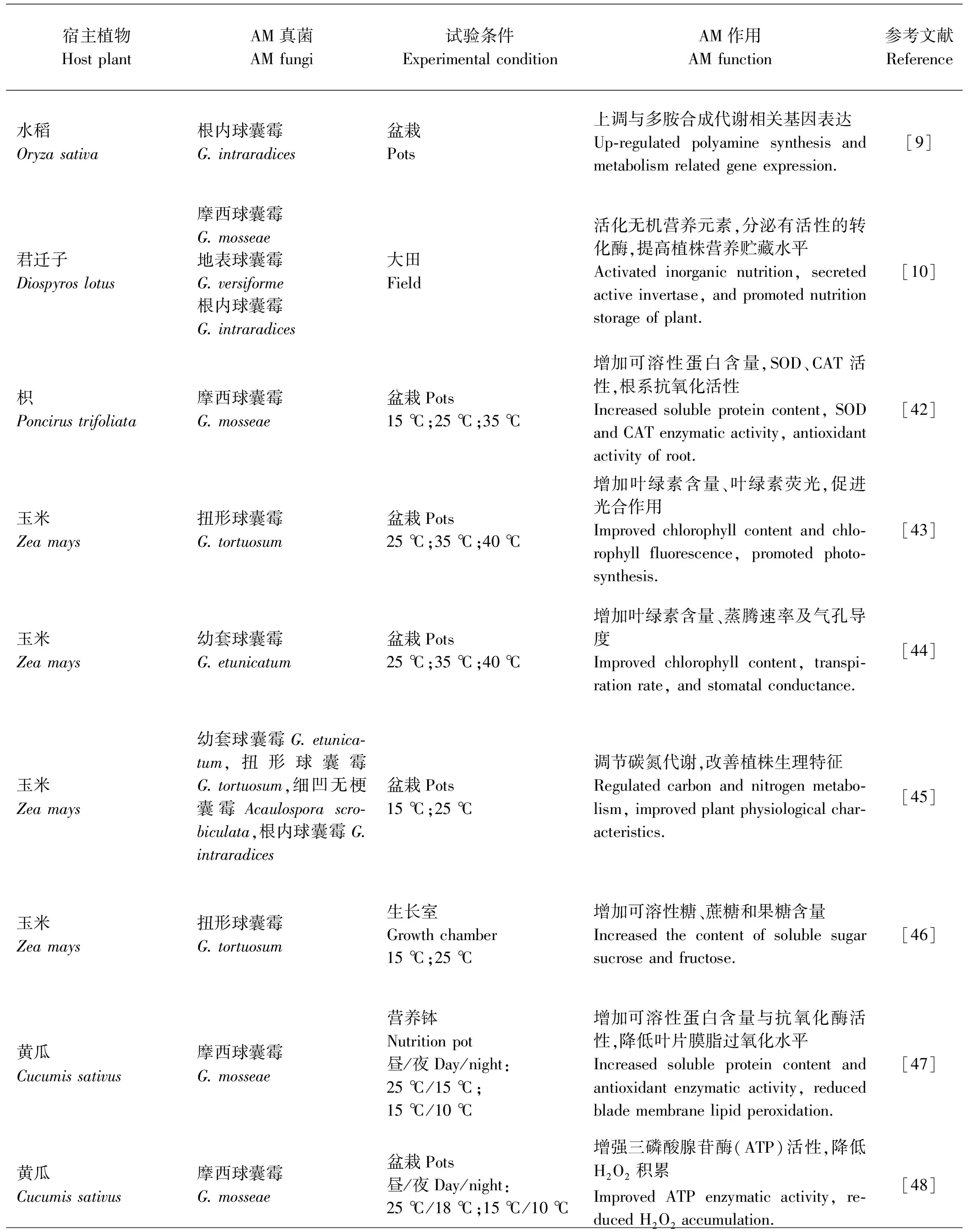
表2 AM真菌对温度胁迫的响应及其机制Table 2 Response and mechanism of AM fungi to temperature stress
续表2
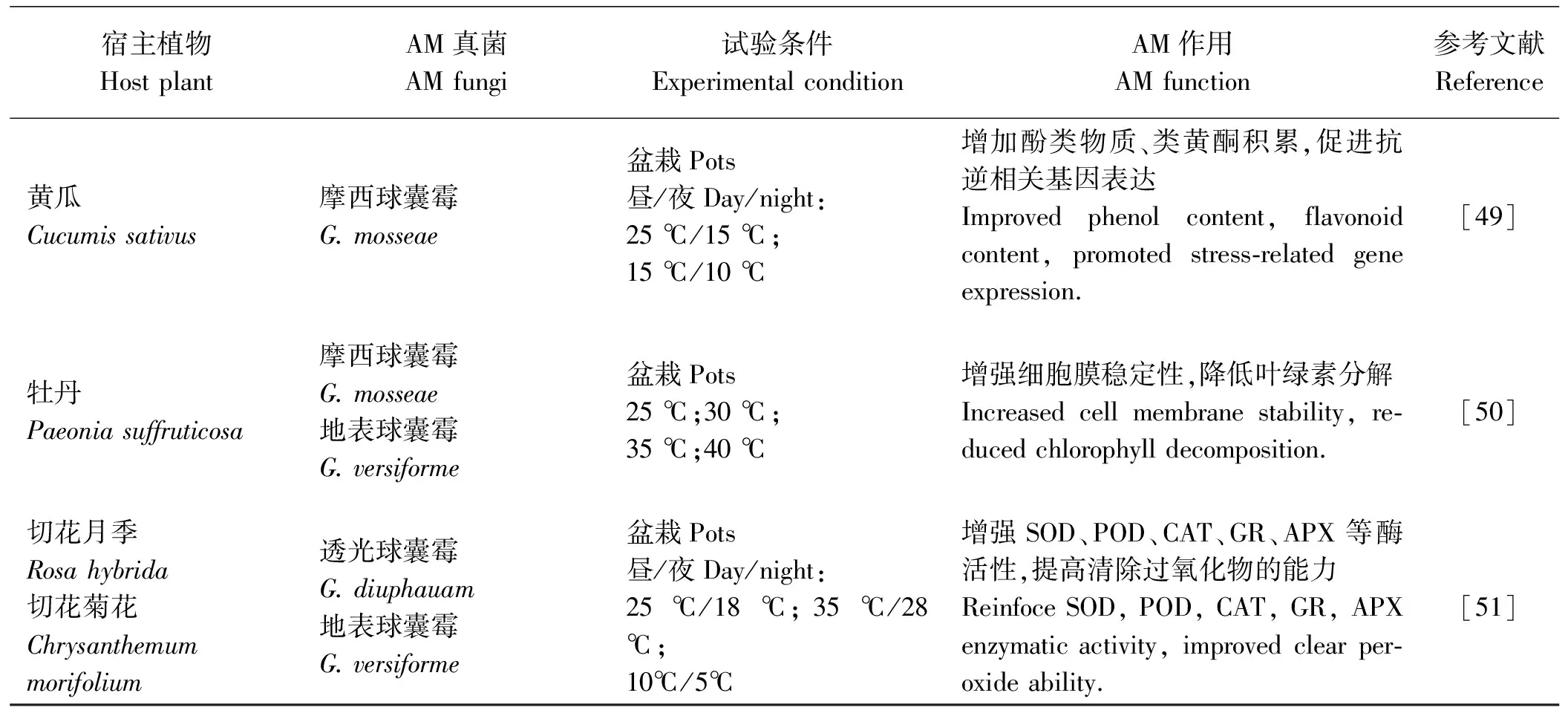
宿主植物HostplantAM真菌AMfungi试验条件ExperimentalconditionAM作用AMfunction参考文献Reference黄瓜Cucumissativus摩西球囊霉G.mosseae盆栽Pots昼/夜Day/night:25℃/15℃;15℃/10℃增加酚类物质、类黄酮积累,促进抗逆相关基因表达Improvedphenolcontent,flavonoidcontent,promotedstress⁃relatedgeneexpression.[49]牡丹Paeoniasuffruticosa摩西球囊霉G.mosseae地表球囊霉G.versiforme盆栽Pots25℃;30℃;35℃;40℃增强细胞膜稳定性,降低叶绿素分解Increasedcellmembranestability,re⁃ducedchlorophylldecomposition.[50]切花月季Rosahybrida切花菊花Chrysanthemummorifolium透光球囊霉G.diuphauam地表球囊霉G.versiforme盆栽Pots昼/夜Day/night:25℃/18℃;35℃/28℃;10℃/5℃增强SOD、POD、CAT、GR、APX等酶活性,提高清除过氧化物的能力ReinfoceSOD,POD,CAT,GR,APXenzymaticactivity,improvedclearper⁃oxideability.[51]
AM真菌提高植物对温度胁迫的抗性其机制主要包括:调节碳氮代谢,促进植物体内碳水化合物的积累,促进氮素吸收,增加植物体内蛋白质氨基酸的合成,从而缓和低温对玉米生长的抑制作用[45];增强SOD、POD、CAT、谷胱甘肽还原酶(GR)、抗坏血酸专一性过氧化物酶(APX)等抗氧化酶类活性,降低膜脂过氧化水平,维持植物细胞质膜的稳定性,提高宿主植物清除O2-·和H2O2等过氧化物的能力,减缓对细胞膜的伤害[42,48,51];减缓叶绿素分解,提高叶绿素含量及叶绿素荧光,促进光合作用,提高气孔导度,加快蒸腾速率,促进植物体内水分循环,增强植物抗逆性[43-44];另外,在受到温度胁迫时,AM真菌可刺激多种胁迫诱导基因(如多胺合成代谢相关基因和植株根系中的Os01g0701500D27、D17、D10等基因)的表达,这些基因均与植物对温度胁迫的应答有关,特异性诱导此类基因表达可有效提高宿主植物对温度胁迫的抵抗能力[9,49]。
1.3 盐碱、重金属
中国盐渍土的分布范围广、面积大、类型多,总面积约1亿hm2[52]。土壤盐碱化不仅可限制植物体的正常生长发育,还会造成严重的生态环境问题[53]。土壤重金属污染不仅对植物生长造成很大危害,还会造成生态环境质量恶化[54]。所以土地盐碱化治理以及消除土壤重金属污染是全球面临亟待解决的资源与生态环境难题。高羊茅(Festucaarundinacea)、羊草(Leymuschinensis)等10种植物与AM真菌共生的研究结果[55-64]表明(表3),盐碱条件下接种摩西球囊霉可显著提高高羊茅叶片抗氧化酶活性,在1.6%的盐胁迫时,接种植株的SOD、POD和CAT活性分别比未接种植株提高了11.2%、8.3%和10.9%;接种摩西球囊霉还可提高抗坏血酸含量,在0.8%、1.2%和1.6%的盐胁迫时,接种植株的抗坏血酸含量分别比未接种植株提高了9.1%、12.4%和19.5%;在1.2% NaCl胁迫下,接种摩西球囊霉的高羊茅叶片与未接种处理相比,丙二醛含量和膜透性分别降低35.4%和25.6%;在0.8%、1.2%和1.6%的盐胁迫时,接种植株的可溶性糖含量分别比未接种处理提高24.2%、16.7%和8.8%,脯氨酸含量分别比未接种处理降低31.3%、30.5%和28.9%[58]。镉胁迫条件下,接种摩西球囊霉可增加水稻植株生物量,促进生长,经测定接种处理的植株地上干重与未接种对照相比,增加幅度为10.76%~59.48%;接种AM真菌能显著提高光能利用率,促进植物光合作用;接种摩西球囊霉后,保证水稻安全生产的土壤镉含量阈值扩增至0.21 mg·kg-1[57]。
在盐碱胁迫下,AM真菌可以提高植物对盐碱的耐受性,缓解对植物体造成的伤害。其抗性机制主要包括提高植物生物量,促进植物生长,增加气孔导度,提高光合色素的积累,促进植物光合作用,加快宿主体内的物质循环与能量转运[64];改变宿主植物体内的渗透调节物质,如增加可溶性糖、可溶性蛋白、氨基酸等的含量及组成,降低丙二醛含量,有效调节植物组织内的渗透平衡,从而提高植物体耐盐碱能力[61,65];提高抗氧化酶类(包括SOD、POD和CAT等)活性和抗氧化剂(抗坏血酸)含量,增强植物抗氧化防御系统,降低氧化胁迫对植物造成的伤害,保证细胞内正常生理生化反应及代谢得以顺利进行;扩大植物根系的吸收范围,提高矿质养分的吸收速率、强化渗透调节作用并维持植物内源激素平衡,减缓离子毒害[58];AM真菌也可以通过调节与耐盐碱相关的基因表达,如独脚金内酯(strigolactone, SL)合成相关基因、根部编码PIP和TIP的基因等,增强植物对盐碱胁迫的抗性效应[55-56]。
在重金属胁迫下,AM真菌可以提高脯氨酸含量,激活超氧化物歧化酶活性,减少氧化胁迫对机体造成的生理伤害,保障细胞代谢及生理生化反应,进而提高对重金属胁迫的抵御能力[57];增强植物根系及菌丝本身对重金属元素的固持作用,抑制其转运,减轻对地上部造成的损伤[66];增加根系细胞中金属螯合物质的含量,促进重金属元素在植物根系的固持,抑制转运,减少地上部植物组织内的重金属含量,提高植物耐重金属性[59];诱导相关抗性基因或蛋白(如PEPC蛋白合成相关基因)的表达,提高植物对重金属污染的耐受性[63]。
2 AM真菌对植物抗生物逆境的抗性机制
2.1 病害
病害是草地生产的重要限制因子之一,病原菌入侵可引致草地植物病害,使草地退化、衰败,不仅造成牧草严重减产,还会影响草地生态系统的持久力和稳定性[67]。 AM真菌可通过与病原菌互作,减轻病害发生,提高植物抗病性[68]。表4中总结了包括黄瓜(Cucumissativus)、西瓜(Citrulluslanatus)在内的多种植物与病原菌、AM真菌形成共生体系,从而影响宿主植物抗病性的研究结果[69-79]。尖孢镰刀菌 (Fusariumoxysporum)可引起黄瓜枯萎病,在黄瓜育苗时接种地表球囊霉可有效减轻尖孢镰刀菌的侵染,经试验测定,双接种地表球囊霉和尖孢镰刀菌可使植株的病情指数较单接种尖孢镰刀菌处理降低37.5%;另对4周龄的黄瓜幼苗双接种尖孢镰刀菌和地表球囊霉,两周后测得植株根系丙二醛含量较相应单接种尖孢镰刀菌处理降低了35%[69]。地表球囊霉同样对尖孢镰刀菌引起的西瓜枯萎病有较好的抑制作用,研究表明在西瓜苗床播种时接种地表球囊霉可以降低根内镰刀菌繁殖体数量,平均比未接种对照减少约59.7%[70]。AM真菌除了可以减轻镰刀菌属(Fusarium)、疫霉菌属(Phytophthora)等根部病原真菌引起的植物病害,还可以抵抗病原线虫的入侵,对线虫病害也有一定防治效果。采用分根培养系统对番茄进行试验,接种摩西球囊霉与南方根结线虫(Meloidogyneincognit)于同一根室,AM 真菌的侵染率受到抑制,病情指数下降34;接种摩西球囊霉与南方根结线虫于不同根室,病情指数下降14[76]。另有研究发现,聚生球囊霉(G.fasciculatu)可以抑制大豆胞囊线虫(Heteroderaglycines)卵囊增长,减少产卵数及幼虫数量,显著降低其病情指数,减轻病害发生程度[77]。AM真菌与病原菌及病原线虫的互作可以有效抑制病原物对植株的侵染、减轻发病率、减少植株死亡率,保证植物正常生长。
AM真菌与病原菌的互作机理是复杂的、多种机制协同作用的结果,主要包括:降低病原菌繁殖体数量,且AM真菌与病原菌存在竞争关系,可以减少病原菌侵染位点,显著降低死株率、发病率和病情指数,降低病害发生程度[70];促进植物细胞皮层加厚,并构建菌丝网络,形成对根部入侵病原真菌的机械屏障,AM真菌的泡囊和丛枝结构也能阻止病原菌菌丝穿过,增强病原真菌侵入根系的难度,减低病原真菌对根系的侵染率[80-81];增强SOD、POD、苯丙氨酸解氨酶(PAL)等多种酶的活性,合成抗细菌和抗真菌的次生代谢产物(主要包括植保素、酶类、酚类化合物和氨基酸类化合物等),保护植物体不受病原菌侵染[82-83];促进植物体对养分元素的吸收与利用,减少病原菌入侵对植物体造成的伤害,增强植物抗性效应[84-85]。
其他机理还包括介导植物抗逆信号转导,如Pozo等[86]研究发现,G.mosseae和G.intraradices可通过诱导植物产生水解酶,减轻植物病害症状。进一步研究发现,植物根系分泌独脚金内酯,诱导AM真菌菌丝伸展及侵染植物,AM真菌侵染初期,诱导植物水杨酸(SA)含量增加,增强植物系统获得抗病性(SAR),当AM真菌进入植物皮层细胞内后,水杨酸含量降低,而丛枝形成阶段,植物茉莉酸(JA)含量提高,同时促进植物脱落酸(ABA)含量增加,增强植物细胞壁抗性。SA、JA等信号传导物质还可诱导防御性基因表达,增强植物抗病能力。另外,AM真菌可改变植物根系分泌物的化学组分,影响根际细菌群落组成,进而诱导植物茉莉酸、乙烯相关系统性抗性[87-88]。AM真菌亦可诱导抗病相关基因的表达,增强效应蛋白如SP7的积累,提高植物抗病性[89-92]。AM真菌对线虫的生长发育及其繁殖同样具有抑制作用,能够抑制线虫卵囊的增长,提高相关酶活性,降低病情指数,有效减轻病原线虫的侵染,降低线虫病害发生[76-79]。
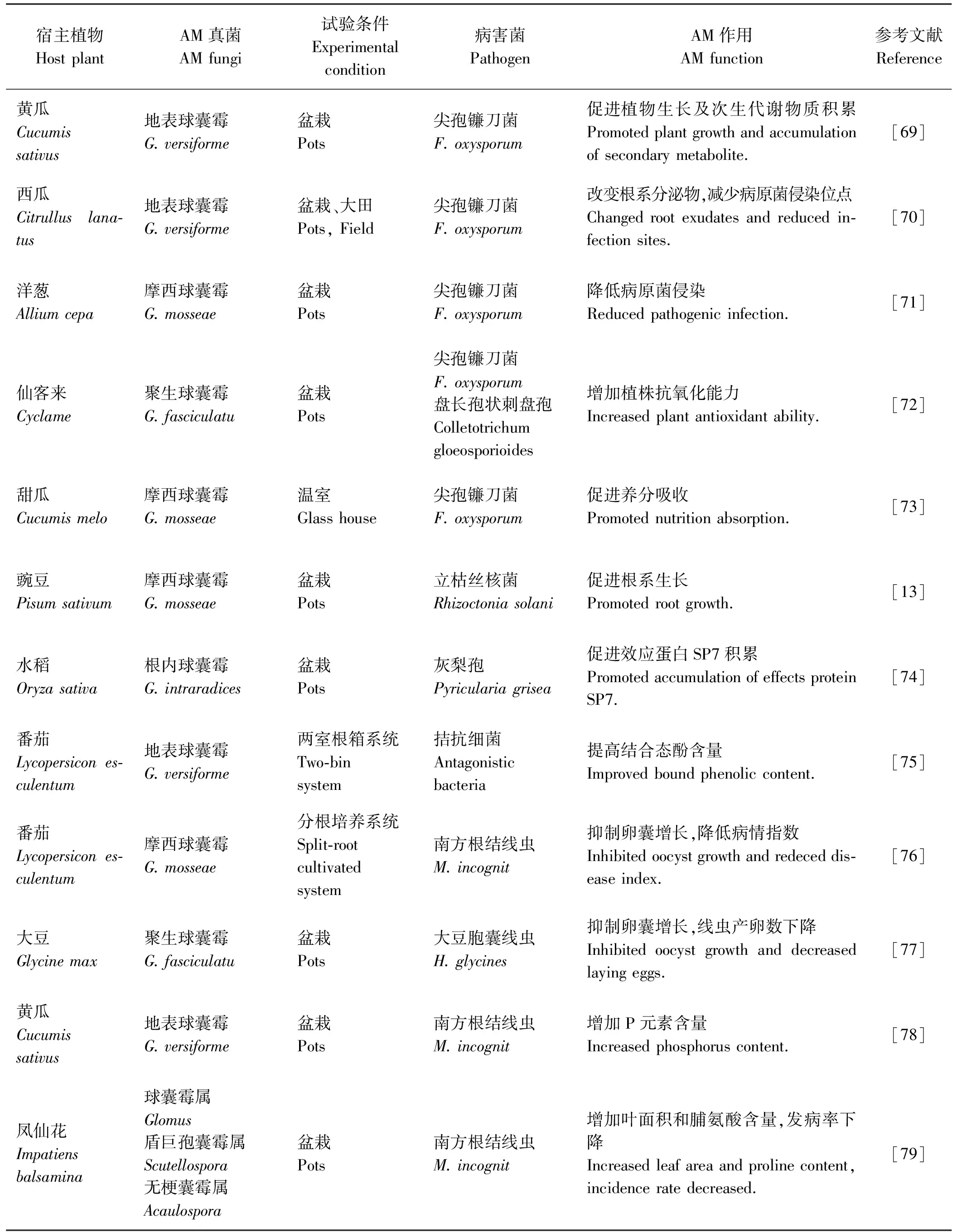
表4 AM真菌对植物抗病性的影响及其机制Table 4 Effects of AM fungi on plant disease resistance and its mechanism
2.2 虫害
昆虫是生物群落中十分重要的组成部分,在植物的生长发育过程中扮演了必不可少的角色。一方面,一些植食性昆虫取食植物叶片,并将植物体作为生长场所,植物正常生长发育受阻,产量及品质降低,严重时甚至可导致植被大面积死亡,危害农林牧业发展,造成严重经济损失。另一方面,一些天敌昆虫可以捕食害虫,减少其对植物的取食及为害,传粉昆虫有助于植物花粉的传播,而有的昆虫还可以携带并传播植物种子。研究AM真菌-植物-昆虫这三者之间的相互作用,对于植物害虫的防治和有益昆虫的保护具有重要指导意义。大量研究表明,AM真菌具有调控植物与昆虫互作的效应[93]。在对垂穗披碱草(Elymusnutans)、长叶车前(Plantagolanceolata)等植物与昆虫相互作用的研究[94-101]表明(表5),幼套球囊霉可以诱导植物产生含量与组分更多的挥发性化合物,主要是萜烯类、醇类、酯类和少量烷烃类物质,通常这类物质是作为植物-昆虫营养关系中信息传递的媒介[94]。Hempel等[98]用摩西球囊霉和根内球囊霉接种梯牧草(Phleumpratense),研究植物、蚜虫(Rhopalosiphumpadi) 与寄生蜂(Aphidiusrhopalosiphi)的相互关系,发现接种AM 真菌可增加植物生物量5.2%,降低蚜虫的虫口数量47%。对矢车菊(Centaureacyanus)的研究[14]则发现AM真菌也可以吸引授粉昆虫,增加其在植株上的访问频率,促进植物传粉。
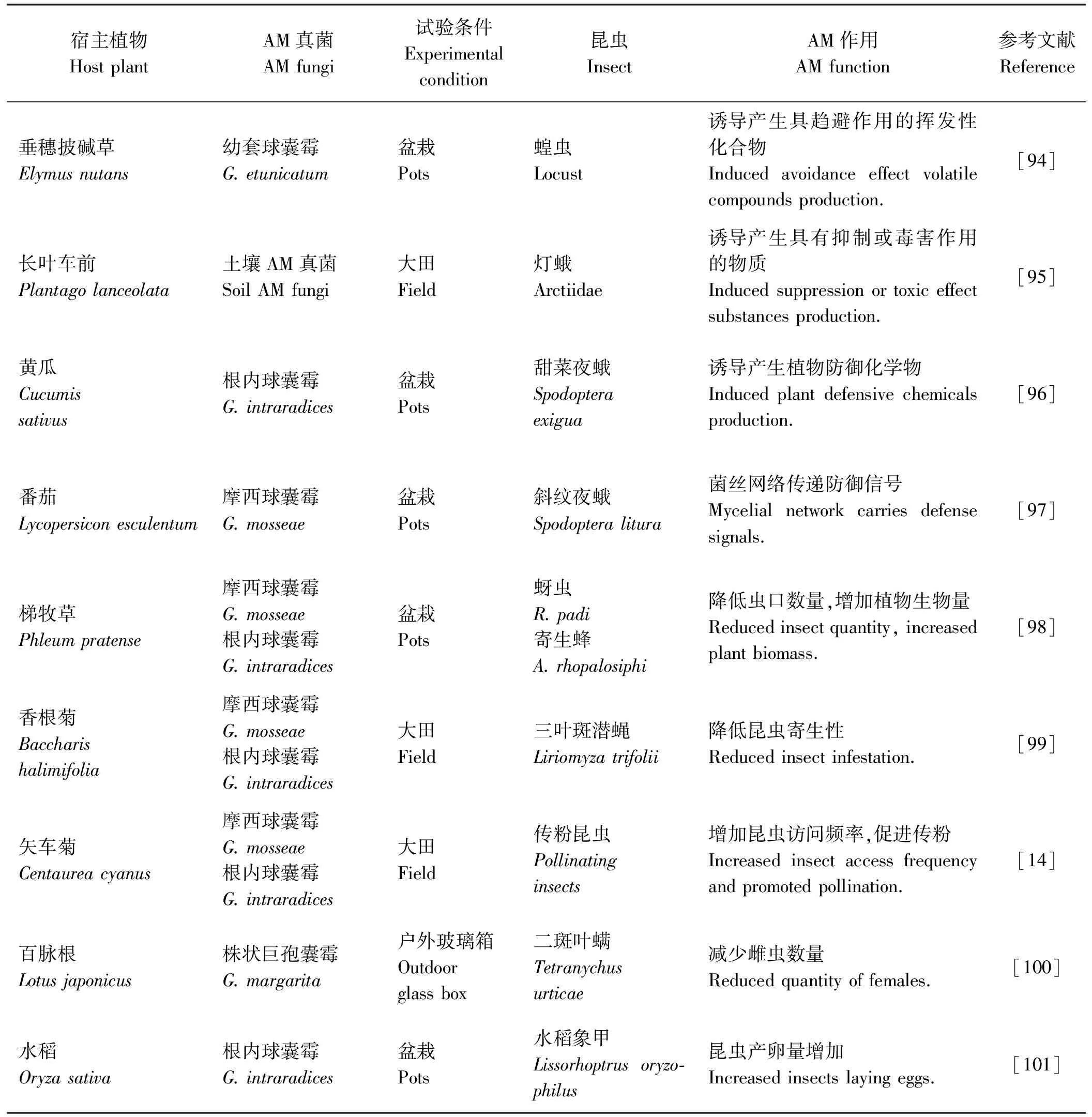
表5 AM真菌对植物抗虫性的影响及其机制Table 5 Effects of AM fungi on plant insect resistance and its mechanism
AM真菌与昆虫的作用机制包括两个方面。一是直接毒杀作用,AM真菌侵染植物后产生的毒性代谢物,对害虫具有抑制或毒杀效果[102];二是间接影响,AM真菌侵染植物后,通过影响植物的营养代谢来影响昆虫的发育及繁殖,也可通过调节害虫天敌间接影响害虫,控制害虫的种群数量[99];诱导植物产生挥发性化合物,如E-2-己烯-1-醇、芳樟醇、苯甲醛、香芹酚等,这类物质对害虫具有趋避作用,可以保护植物,减少昆虫取食,提高植物抗虫性[94,97];另外,一旦害虫取食植物,AM真菌可以通过强大的菌丝网络在邻近植株间传递抗虫防御信号,使邻近植株及时进入防御状态,减少害虫取食[97]。AM真菌菌丝网络传递信号的功能极为稳定可靠,因此在害虫防治以及有益昆虫保护等方面应用前景十分广泛。
3 展望
随着国家“粮改饲”及种植业结构调整政策的进一步深入,草地农业在食物安全及生态环境建设中的重要性日益突出。草地多分布在干旱、高寒、土壤贫瘠地区,逆境胁迫严重影响植物的生长发育,造成牧草减产和草地退化。因此,提高草类植物对逆境的抗性,对于提高牧草产量,促进系统种群多样性以及维持草地生态系统稳定极其重要。目前有关于AM真菌与植物互作的研究主要集中于少数几个AM真菌属,如病害多限于球囊霉属的研究,鉴于不同AM真菌对植物抗逆性影响不同,应加强对菌根真菌多样性及丰富度对草地植物抗逆的影响及机理的研究;同时,目前的研究多为人工模拟单一逆境,应加强AM真菌-草地植物对多种逆境因子响应的研究[103-105]。机理方面,AM真菌提高植物抗逆机理包括促进植物养分吸收、生长,调节植物生理、生化代谢,诱导信号介导,基因及蛋白表达等诸多方面,应关注不同抗性机理的相关性,强化现代分子生物学技术和细胞学技术应用,推动AM真菌在促进植物抗逆机理方面的研究。
References:
[1] Smith S E,Read D J.Mycorrhizal Symbiosis.New York:Academic Press,2010.
[2] Sawers R J H,Svane S F,Quan C,Grønlund M,Wozniak B,Gebreselassie M N,González-Muoz E,Chávez Montes R A,Baxter I,Goudet J,Jakobsen I,Paszkowski U.Phosphorus acquisition efficiency in arbuscular mycorrhizal maize is correlated with the abundance of root-external hyphae and the accumulation of transcripts encoding PHT1 phosphate transporters.New Phytologist,2017,214(2):632-643.
[3] 郭艳娥,李芳,李应德,段廷玉.AM真菌促进植物吸收利用磷元素的机制.草业科学,2016,33(12):2379-2390.
Guo Y E,Li F,Li Y D,Duan T Y.Progress in the elucidation of the mechanisms of arbuscular mycorrhizal fungi in promotion of phosphorus uptake and utilization by plants.Pratacultural Science,2016,33(12):2379-2390.(in Chinese)
[4] Zhang W,Chen X X,Liu Y M,Liu D Y,Chen X P,Zou C Q.Zinc uptake by roots and accumulation in maize plants as affected by phosphorus application and arbuscular mycorrhizal colonization.Plant and Soil,2017,413(1/2):59-71.
[5] Tian H,Yuan X L, Duan J F,Li W H,Zhai B N,Gao Y J.Influence of nutrient signals and carbon allocation on the expression of phosphate and nitrogen transporter genes in winter wheat (Triticumaestivum L.) roots colonized by arbuscular mycorrhizal fungi.PLoS One,2017,12(2):e0172154.
[6] Zhang H Q,Wei S Z,Hu W T,Xiao L M,Tang M.Arbuscular mycorrhizal fungus Rhizophagus irregularis increased potassium content and expression of genes encoding potassium channels inLyciumbarbarum.Frontiers in Plant Science,2017,8:440.
[7] Leyval C,Turnau K,Haselwandter K.Effect of heavy metal pollution on mycorrhizal colonization and function:Physiological,ecological and applied aspects.Mycorrhiza,1997,7(3):139-153.
[8] Augé R M.Water relations,drought and vesicular-arbuscular mycorrhizal symbiosis.Mycorrhiza,2001,11(1):3-42.
[9] 齐国辉,杨文利,张林平,李宪涛,高素娜.丛枝菌根真菌对君迁子贮藏营养及抗冻性的影响.河北农业大学学报,2005,28(1):62-64.
Qi G H,Yang W L,Zhang L P,Li X T,Gao S N.Effects of arbuscular mycorrhizal fungi on storage nutrient and cold resistance ofDiospyroslotusL.Journal of Agricultural University of Hebei,2005,28(1):62-64.(in Chinese)
[10] Liu Z,Li Y,Wang J,He X,Tian C.Different respiration metabolism between mycorrhizal and non-mycorrhizal rice under low-temperature stress:A cry for help from the host.The Journal of Agricultural Science,2015,153(4):602-614.
[11] Garg N,Pandey R.Effectiveness of native and exotic arbuscular mycorrhizal fungi on nutrient uptake and ion homeostasis in salt-stressedCajanuscajanL.(Millsp.) genotypes.Mycorrhiza,2015,25(3):165-180.
[12] Galli U,Schüepp H,Brunold C.Heavy metal binding by mycorrhizal fungi.Physiologia Plantarum,1994,92(2):364-368.
[13] Morandi D,Gollotte A,Camporota P.Influence of an arbuscular mycorrhizal fungus on the interaction of a binucleate Rhizoctonia species with Myc+and Myc-pea roots.Mycorrhiza,2002,12(2):97-102.
[14] Gange A C,Smith A K.Arbuscular mycorrhizal fungi influence visitation rates of pollinating insects.Ecological Entomology,2005,30(5):600-606.
[15] Van der Heijden M G A,Boller T W,Sanders R.Different arbuscular mycorrhizal fungal species are potential determinants of plant community structure.Ecology,1998,79(6):2082-2091.
[16] Ehrenfeld J G,Ravit B,Elgersma K.Feedback in the plant-soil system.Annual Review of Environment and Resources,2005,30(1):75-115.
[17] Lin G,McCormack M L,Ma C,Guo D.Similar below-ground carbon cycling dynamics but contrasting modes of nitrogen cycling between arbuscular mycorrhizal and ectomycorrhizal forests.New Phytologist,2017,213(3):1440-1451.
[18] 王贤波.丛枝菌根(AM)的研究进展及展望.杭州农业科技,2007(2):19-21.
Wang X B.Research progress and prospects of arbuscular mycorrhizae(AM).Hangzhou Agricultural Technology,2007(2):19-21.(in Chinese)
[19] Gui H,Hyde K,Xu J C,Mortimer P.Arbuscular mycorrhiza enhance the rate of litter decomposition while inhibiting soil microbial community development.Scientific Reports,2017,7(7):42184.
[20] 王立,贾文奇,马放,李世阳,张淑娟.菌根技术在环境修复领域中的应用及展望.生态环境学报,2010,19(2):487-493.
Wang L,Jia W Q,Ma F,Li S Y,Zhang S J.Mycorrhizal technology application and prospects in the field of environmental remediation.Journal of Ecological Environment,2010,19(2):487-493.(in Chinese)
[21] Zhang T,Sun Y,Shi Z Y,Feng G.Arbuscular mycorrhizal fungi can accelerate the restoration of degraded spring grassland in Central Asia.Journal of Rangeland Ecology and Management,2012,65(4):426-432.
[22] Boyer J S.Plant productivity and environment.Science,1982,218:443-448.
[23] Ciais P H,Reichstein M,Viovy N,Granier A,Ogée J,Allard V,Aubinet M,Buchmann N,Bernhofer C,Carrara A,Chevallier F,de Noblet N,Friend A D,Friedllingstein P,Grünwald T,Heinesch B,Keronen P,Knohl A,Krinner G,Loustau D,Manca G,Matteucci G,Miglietta F,Ourcival J M,Papale D,Pilegaard K,Rambal S,Seufert G,Soussana J F,Sanz M J,Schulze E D,Vesala T,Valentini R.Europe-wide reduction in primary productivity caused by the heat and drought in 2003.Nature,2005,437:529-533.
[24] Qian Y B,Jiang J,Wu Z N.Soil heterogeneity and its impact on ecological distribution of plant community in the aiby lake area.Arid Land Geography,2003,26(3):217-222.
[25] 李芳,高萍,段廷玉.AM菌根真菌对非生物逆境的响应及其机制.草地学报,2016,24(3):491-500.
Li F,Gao P,Duan T Y.Response and mechanism of arbuscular mycorrhizal fungi to abiotic stress.Journal of Grassland,2016,24(3):491-500.(in Chinese)
[26] 任爱天,鲁为华,马春晖,杨洁晶.接种AM真菌对紫花苜蓿抗旱性的影响.新疆农业科学,2014,51(9):1677-1685.
Ren A T,Lu W H,Ma C H,Yang J J.Effect of arbuscular mycorrhiza fungi on drought tolerance ofMedicagosativaL.Xinjiang Agricultural Science,2014,51(9):1677-1685.(in Chinese)
[27] 张海涵.黄土高原枸杞根际微生态特征及其共生真菌调控寄主生长与耐旱响应机制.杨凌:西北农林科技大学博士学位论文,2011.
Zhang H H.Micro-ecosystem associated with the rhizosphere ofLyciumbarbarumfrom the loess plateau and the mechanism of symbiotic fungal inoculation on the host plant growth and drought resistance.PhD Thesis.Yangling:North West Agriculture and Forestry University,2011.(in Chinese)
[28] 贺学礼,高露,赵丽莉.水分胁迫下丛枝菌根AM真菌对民勤绢蒿生长与抗旱性的影响.生态学报,2011,31(4):1029-1037.
He X L,Gao L,Zhao L L.Effects of AM fungi on the growth and drought resistance ofSeriphidiumminchünenseunder water stress.Ecology,2011,31(4):1029-1037.(in Chinese)
[29] 赵平娟,安锋,唐明.丛枝菌根真菌对连翘幼苗抗旱性的影响.西北植物学报,2007,27(2):396-399.
Zhao P J,An F,Tang M.Effects of arbuscular mycorrhiza fungi on drought resistance ofForsythiasuspensa.Journal of Northwest Botany,2007,27(2):396-399.(in Chinese)
[30] Zézé A,Brou Y C,Meddich A,Marty F.Molecular identification of MIP genes expressed in the roots of an arbuscular mycorrhizalTrifoliumalexandriumL. under water stress.African Journal of Agricultural Research,2008,3(1):78-83.
[31] Aroca R,del Mar Alguacil M,Vernieri P,Ruiz-Lozano J M.Plant responses to drought stress and exogenous ABA application are modulated differently by mycorrhization in tomato and an ABA-deficient mutant (sitiens).Microbial Ecology,2008,56(4):704-719.
[32] Ruiz-Lozano J M,Porcel R,Aroca R.Does the enhanced tolerance of arbuscular mycorrhizal plants to water deficit involve modulation of droughtinduced plant genes?New Phytologist,2006,171(4):693-698.
[33] 陈婕,谢靖,唐明.水分胁迫下丛枝菌根真菌对紫穗槐生长和抗旱性的影响.北京林业大学报,2014,36(6):142-148.
Chen J,Xie J,Tang M.Effects of arbuscular mycorrhizal fungi on the growth and drought resistance ofAmorphafruticosaunder water stress.Journal of Beijing Forestry University,2014,36(6):142-148.(in Chinese)
[34] 黄志.丛枝菌根真菌对甜瓜抗旱性的生理效应及分子机制的研究.杨凌:西北农林科技大学博士学位论文,2010.
Huang Z.Studies on the physiological effect and mechanisms of arbuscular mycorrhizal fungi (AMF) in drought resistance of Melon.PhD Thesis.Yangling:North West Agriculture and Forestry University,2010.(in Chinese)
[35] Ruiz-Lozano J M,del Mar Alguacil M,Bárzana G,Vernieri P,Aroca R.Exogenous ABA accentuates the differences in root hydraulic properties between mycorrhizal and non mycorrhizal maize plants through regulation of PIP aquaporins.Plant Molecular Biology,2009,70(5):565-579.
[36] 张华.AM真菌对小叶锦鸡儿和蒙古扁桃生长、抗旱性及总黄酮含量的影响.呼和浩特:内蒙古大学硕士学位论文,2013.
Zhang H.The effects of AM fungi on growth,drought resistance and total flavonoids content ofCaraganamicrophyllaLam. andAmygdalusmongolicaMaxim.Master Thesis.Hohhot:University of Inner Mongolia,2013.(in Chinese)
[37] Goicoechea N,Merino S,Sánchez-Díaz M.Arbuscular mycorrhizal fungi can contribute to maintain antioxidant and carbon metabolism in nodules ofAnthylliscytisoidesL. subjected to drought.Journal of Plant Physiology,2005,162(1):27-35.
[38] Subramanian K S,Santhanakrishnan P,Balasubramanian P.Responses of field grown tomato plants to arbuscular mycorrhizal fungal colonization under varying intensities of drought stress.Scientia Horticulturae,2006,107(3):245-253.
[39] Qin X,Zeevaart J A D.The 9-cis-epoxycarotenoid cleavage reaction is the key regulatory step of abscisic acid biosynthesis in water-stressed bean.Proceedings of the National Academy of Sciences,1999,96(26):15354-15361.
[40] Rillig M C,Wright S F,Eviner V T.The role of arbuscular mycorrhizal fungi and glomalin in soil aggregation:Comparing effects of five plant species.Plant and Soil,2002,238(2):325-333.
[41] Jiang W,Gou G,Ding Y.Influences of arbuscular mycorrhizal fungi on growth and mineral element absorption of chenglu hybrid bamboo seedlings.Pakistan Journal of Botany,2013,45(1):303-310.
[42] 潘传威,刘小芳,屈鹏飞,吴强盛.丛枝菌根真菌提高温度胁迫下枳根系抗氧化能力.长江大学学报(自然科学版),2011,8(9):245-247.
Pan C W,Liu X F,Qu P F,Wu Q S.Arbuscular mycorrhizal fungi increased antioxidant capacity ofPoncirustrifoliataroots under temperature stress.Journal of Yangtze University(Natural Science Edition),2011,8(9):245-247.(in Chinese)
[43] 陈笑莹,宋凤斌,朱先灿,刘胜群,柏会子.高温胁迫下丛枝菌根真菌对玉米光合特性的影响.华北农学报,2013,28(2):108-113.
Chen X Y,Song F B,Zhu X C,Liu S Q,Bai H Z.Effects of arbuscular mycorrhizal fungi on photosynthetic characteristics in maize plants under high temperature stress.Agriculture in North China,2013,28(2):108-113.(in Chinese)
[44] Zhu X C,Song F B,Liu S Q,Liu T D.Effects of arbuscular mycorrhizal fungus on photosynthesis and water status of maize under high temperature stress.Plant and Soil,2011,346(1/2):189-199.
[45] 陈笑莹.低温胁迫下丛枝菌根真菌对玉米碳氮代谢的影响.长春:中国科学院研究生院(东北地理与农业生态研究所)博士学位论文,2014.
Chen X Y.Effects of arbuscular mycorrhizal fungi on carbon and nitrogen metabolism of maize under low temperature stress.PhD Thesis.Changchun:Graduate School of Chinese Academy of Sciences(Northeast Institute of Geography and Agricultural Ecology),2014.(in Chinese)
[46] Zhu X C,Song F B,Liu F L,Liu S Q,Tian C J.Carbon and nitrogen metabolism in arbuscular mycorrhizal maize plants under low-temperature stress.Crop and Pasture Science,2015,66(1):62-70.
[47] 韩冰,贺超兴,闫妍,郭世荣,于贤昌.AMF对低温胁迫下黄瓜幼苗生长和叶片氧化系统的影响.中国农业科学,2011,44(8):1646-1653.
Han B,He C X,Yan Y,Guo S R,Yu X C.Effects of arbuscular mycorrhiza fungi on seedlings growth and antioxidant systems of leaves in cucumber under low temperature stress.Chinese Academy of Agricultural Sciences,2011,44(8):1646-1653.(in Chinese)
[48] Liu A,Chen S,Chang R,Liu D,Chen H,Ahammed G J,Lin X,He C.Arbuscular mycorrhizae improve low temperature tolerance in cucumber via alterations in H2O2accumulation and ATPase activity.Journal of Plant Research,2014,127(6):775-785.
[49] Chen S,Jin W,Liu A,Zhang S,Liu D,Wang F,Lin X,He C.Arbuscular mycorrhizal fungi (AMF) increase growth and secondary metabolism in cucumber subjected to low temperature stress.Scientia Horticulturae,2013,160:222-229.
[50] 李思龙,张玉刚,陈丹明,马健,郭绍霞.丛枝菌根对高温胁迫下牡丹生理生化的影响.中国农学通报,2009,25(7):154-157.
Li S L,Zhang Y G,Chen D M,Ma J,Guo S X.Effect of arbuscular mycorrhizal fungi on physiology and biochemistry of tree peony under high temperature stress.Chinese Agricultural Science Bulletin,2009,25(7):154-157.(in Chinese)
[51] 孔佩佩.丛枝菌根真菌对切花月季和切花菊生长及温度胁迫耐受性的影响.北京:中国农业科学院硕士学位论文,2011.
Kong P P.Effects of arbuscular mycorrhizal fungi on growth and temperature tolerance ofRosanybridandChrysanthemummorifolium.Master Thesis.Beijing:Chinese Academy of Agricultural Sciences,2011.(in Chinese)
[52] 杨劲松.中国盐渍土研究的发展历程与展望.土壤学报,2008,45(5):837-845.
Yang J S.Development history and prospect of research on saline soil in China.Journal of Soil,2008,45(5):837-845.(in Chinese)
[53] Porcel R,Aroca R,Ruiz-Lozano J.Salinity stress alleviation using arbuscular mycorrhizal fungi:A review.Agronomy for Sustainable Development,2012,32(1):181-200.
[54] 王红新.丛枝菌根真菌在植物修复重金属污染土壤中的作用.中国土壤与肥料,2010(5):1-5.
Wang H X.Arbuscular mycorrhizal fungi’s role in the phytoremediation of soils contaminated by heavy metals.Soils and Fertilizers in China,2010(5):1-5.(in Chinese)
[55] Ouziad F,Wilde P,Schmelzer E,Hildebrandt U,Bothe H.Analysis of expression of aquaporins and Na+/H+transporters in tomato colonized by arbuscular mycorrhizal fungi and affected by salt stress.Environmental and Experimental Botany,2006,57(1/2):177-186.
[56] 张瑞萍.水稻质膜质子泵基因对低磷胁迫的响应和丛枝菌根的影响.南京:南京农业大学博士学位论文,2011.
Zhang R P.Adaptation to Pi deficiency and effects to mycorrhiza of the rice plasma membrane H+-ATPasegenes.PhD Thesis.Nanjing:Nanjing Agricultural University,2011.(in Chinese)
[57] 刘双洋.丛枝菌根真菌对水稻镉胁迫响应及其转运过程的影响研究.哈尔滨:哈尔滨工业大学硕士学位论文,2015.
Liu S Y.The research on response to cadmium stress and transport process of rice under infection of arbuscular mycorrhizal fungi.Master Thesis.Harbin:Harbin Institute of Technology,2015.(in Chinese)
[58] 杨海霞,刘润进,郭绍霞.AM真菌摩西球囊霉对盐胁迫条件下高羊茅生长特性的影响.草业学报,2014,23(4):195-203.
Yang H X,Liu R J,Guo S X.Effects of arbuscular mycorrhizal fungi Glomus mosseae on growth characteristics ofFestucaarundinaceaunder salt stress.Acta Prataculturae Sinica,2014,23(4):195-203.(in Chinese)
[59] 李霞,彭霞薇,伍松林,李志茹,冯红梅,江泽平.丛枝菌根对翅荚木生长及吸收累积重金属的影响.环境科学,2014,35 (8):3142-3148.
Li X,Peng X W,Wu S L,Li Z R,Feng H M,Jiang Z P.Effect of arbuscular mycorrhizae on growth,heavy metal uptake and accumulation ofZeniainsignischun seedlings.Environmental Science,2014,35(8):3142-3148.(in Chinese)
[60] 黄晶,凌婉婷,孙艳娣,刘娟.丛枝菌根真菌对紫花苜蓿吸收土壤中镉和锌的影响.农业环境科学学报,2012,31(1):99-105.
Huang J,Ling W T,Sun Y D,Liu J.Impacts of arbuscular mycorrhizal fungi inoculation on the uptake of cadmium and zinc by alfalfa in contaminated soil.Journal of Agro-environmental Science,2012,31(1):99-105.(in Chinese)
[61] Moradi A,Younesi O.Influence of arbuscular mycorrhiza on membrane lipid peroxidation and soluble sugar content of soybean under salt stress.Agriculturae Conspectus Scientificus,2015,79(4):227-232.
[62] He Z Q,Huang Z.Expression analysis ofLeNHX1 gene in mycorrhizal tomato under salt stress.Journal of Microbiology, 2013,51(1):100-104.
[63] 周权男,杨礼富,王真辉.砷胁迫对丛枝菌根接种玉米叶片蛋白表达谱的影响.西南农业学报,2014,27(6):2370-2373.
Zhou Q N,Yang L F,Wang Z H.Effect of arsenic stress on protein expression profiles from maize leaves of abuscular mycorrhizal fungi (AMF) inoculation.Southwest Journal of Agriculture Science,2014,27(6):2370-2373.(in Chinese)
[64] Lin J X,Wang Y N,Sun S N,Mu C S,Yan X F.Effects of arbuscular mycorrhizal fungi on the growth,photosynthesis and photosynthetic pigments ofLeymuschinensisseedlings under salt-alkali stress and nitrogen deposition.Science of the Total Environment,2017,576:234-241.
[65] Evelin H,Kapoor R,Giri B.Arbuscular mycorrhizal fungi in alleviation of salt stress:A review.Annals of Botany,2009, 104(7):1263-1280.
[66] 林双双,孙向伟,王晓娟,李媛媛,罗巧玉,孙莉,金樑.AM真菌提高寄主植物耐受重金属胁迫的生理机制.草业科学,2013,30(3):365-374.
Lin S S,Sun X W,Wang X J,Li Y Y,Luo Q Y,Sun L,Jin L.Mechanisms of AM fungi to increase physiological tolerance to heavy metal of host plant.Pratacultural Science,2013,30(3):365-374.(in Chinese)
[67] 南志标,李春杰,白原生.我国草类作物病害及其防治对策.北京:海洋出版社,2003.
Nan Z B,Li C J,Bai Y S.Grass Plant Diseases and Their Control Countermeasures in China.Beijing:China Ocean Press,2003.(in Chinese)
[68] 张峰,段廷玉,闫飞扬,李芳.丛枝菌根真菌与根际微生物的互作.草业科学,2014,31(9):1673-1685.
Zhang F,Duan T Y,Yan F Y,Li F.Advances in the interactions of arbuscular mycorrhizal fungi and rhizosphere microorganism.Pratacultural Science,2014,31(9):1673-1685.(in Chinese)
[69] 王倡宪.AM真菌对设施黄瓜幼苗生长及抗枯萎病能力研究.北京:中国农业大学博士学位论文,2005.
Wang C X.Studies on effects of AMF on growth and resistance of cucumber seedlings to wilt disease under protected conditions.PhD Thesis.Beijing:China Agricultural University,2005.(in Chinese)
[70] 李敏.AM真菌对西瓜抗枯萎病的效应及其机制.北京:中国农业大学博士学位论文,2005.
Lin M.Effects of AM fungi on resistance to Fusarium wilt in watermelon (Citrulluslanatus) and related mechanism.PhD Thesis.Beijing:China Agricultural University,2005.(in Chinese)
[71] Safir G R.The Influence of vesicular-arbuscular mycorrhiza on the resistance on onion toPyrenochaetaterrestris.Master Thesis.Urbana:University of Illinois,1968.
[72] Maya M A,Matsubara Y.Tolerance toFusariumwiltand anthracnose diseases and changes of antioxidative activity in mycorrhizal cyclamen.Crop Protection,2013,47:41-48.
[73] Martínez-Medina A,Roldán A,Pascual J A.Interaction between arbuscular mycorrhizal fungi andTrichodermaharzianumunder conventional and low input fertilization field condition in melon crops:Growth response andFusariumwiltbiocontrol.Applied Soil Ecology,2011,47(2):98-105.
[74] Kloppholz S,Kuhn H,Requena N.A secreted fungal effector ofGlomusintraradicespromotes symbiotic biotrophy.Current Biology,2011,21(14):1204-1209.
[75] 朱红惠,姚青,羊宋贞.AM真菌与拮抗细菌的互作及对番茄根系酚类物质的影响.华南农业大学学报,2003,24(3):20-23.
Zhu H H,Yao Q,Yang S Z.Interaction between AM fungus and antagonistic bacterium and its effect on tomato root phenolic compounds.Journal of South China Agricultural University,2003,24(3):20-23.(in Chinese)
[76] 盛萍萍,王彬,苑学霞,王小坤,刘润进.AM真菌诱导的番茄信号物质及其对根结线虫的抑制效应.植物病理学报,2012,42(3):323-327.
Sheng P P,Wang B,Yuan X X,Wang X K,Liu R J.Physiological effect of signal substances in tomato plants induced by arbuscular mycorrhizal fungi.Plant Pathology Journal,2012,42(3):323-327.(in Chinese)
[77] 李海燕,刘润进,束怀瑞.丛枝菌根真菌与大豆胞囊线虫相互作用研究初报.植物病理学报,2002,32(4):356-360.
Li H Y,Liu R J,Shu H R.A preliminary report on interactions between arbuscular mycorrhizal fungi and soybean cyst nematode.Plant Pathology Journal,2002,32(4):356-360.(in Chinese)
[78] 陈书霞,姜永华,刘宏久,程智慧.AM真菌和根结线虫互作对黄瓜生长及生理特征的影响.植物保护学报,2012,39(3):253-259.
Chen S X,Jiang Y H,Liu H J,Chen Z H.Interaction between AM fungi and root-knot nematodes cucumber growth and the effect for physiological characteristics.Journal of Plant Protection,2012,39(3):253-259.(in Chinese)
[79] Banuelos J,Trejo D,Alarcon A,Lara L,Moreira C,Cruz S.The reduction in proline buildup in mycorrhizal plants affected by nematodes.Journal of Soil Science and Plant Nutrition,2012,12(2):263-270.
[80] Merrild M P,Ambus P,Rosendahl S,Jakobsen L.Common arbuscular mycorrhizal networks amplify competition for phosphorus between seedlings and established plants.New Phytologist,2013,200(1):229-240.
[81] Hardham A R,Mitchell H J.Use of molecular cytology to study the structure and biology of phytopathogenic and mycorrhizal fungi.Fungal Genetics and Biology,1998,24(1):252-284.
[82] Ortu G,Balestrini R,Pereira P A,Becker J D,Küster H,Bonfante P.Plant genes related to gibberellin biosynthesis and signaling are differentially regulated during the early stages of AM fungal interactions.Molecular Plant,2012,5(4):951-954.
[83] Fiorilli V,Catoni M,Francia D,Cardinale F,Lanfranco L.The arbuscular mycorrhizal symbiosis reduces disease severity in tomato plants infected byBotrytiscinerea.Journal of Plant Pathology,2011,93(1):237-242.
[84] Abbott L K,Robson A D.The role of vesicular arbuscular mycorrhizal fungi in agriculture and the selection of fungi for inoculation.Crop and Pasture Science,1982,33(2):389-408.
[85] Thompson J P,Wildermuth G B.Colonization of crop and pasture species with vesicular-arbuscular mycorrhizal fungi and a negative correlation with root infection byBipolarissorokiniana.Canadian Journal of Botany,1989,67(3):687-693.
[86] Pozo M J,Cordier C,Dumas-Gaudot E,Gianinazzi S,Barea J M,Azcon-Aguilar C.Localized versus systemic effect of arbuscular mycorrhizal fungi on defence responses toPhytophthorainfectionin tomato plants.Journal of Experimental Botany,2002,53:525-534.
[87] Cameron D D,Neal A L,van Wees S C M,Ton J.Mycorrhiza-induced resistance:more than the sum of its parts?Trends in Plant Science,2013,18(10):539-545.
[88] Pozo M J,Azcon-Aguilar C.Unraveling mycorrhiza-induced resistance.Current Opinion in Plant Biology,2007,10(4):393-398.
[89] Ruiz-Lozano J M,Roussel H,Gianinazzi S,Gianinazzi-Pearson V.Defense genes are differentially induced by a mycorrhizal fungus andRhizobiumsp. in wild-type and symbiosis-defective pea genotypes.Molecular Plant-Microbe Interactions,1999,12(11):976-984.
[90] Pozo M J,Azcón-Aguilar C,Dumas-Gaudot E,Barea J M.β-1,3-glucanase activities in tomato roots inoculated with arbuscular mycorrhizal fungi and/or phytophthora parasitica and their possible involvement in bioprotection.Plant Science,1999,141(2):149-157.
[91] Gao L L,Smith F A,Smith S E.The rmc locus does not affect plant interactions or defence-related gene expression when tomato (Solanumlycopersicum) is infected with the root fungal parasite,Rhizoctonia.Functional Plant Biology,2006,33(3):289-296.
[92] Gao L L,Knogge W,Delp G,Smith F A,Smith S E.Expression patterns of defense-related genes in different types of arbuscular mycorrhizal development in wild-type and mycorrhiza-defective mutant tomato.Molecular Plant-Microbe Interactions,2004,17(10):1103-1113.
[93] Vannette R L,Rasmann S.Arbuscular mycorrhizal fungi mediate below-ground plant-herbivore interactions:A phylogenetic study.Functional Ecology,2012,26(5):1033-1042.
[94] 刘月华,钟梦莹,武瑞鑫,位晓婷,潘多,邵新庆.AM真菌介导垂穗披碱草抗虫作用研究.草地学报,2016,24(3):604-609.
Liu Y H,Zhong M Y,Wu R X,Wei X T,Pan D,Shao X X.Study of the inductive effect of arbuscular mycorrhizal fungi onElymusnutanspest-resistant information.Journal of Grassland,2016,24(3):604-609.(in Chinese)
[95] Gange A C,West H M.Interactions between arbuscular mycorrhizal fungi and foliar-feeding insects inPlantagolanceolataL.New Phytologist,1994,128(1):79-87.
[96] Barber N A.Arbuscular mycorrhizal fungi are necessary for the induced response to herbivores byCucumissativus. Journal of Plant Ecology,2013,6(2):171-176.
[97] Xie L J,Song Y Y,Zeng R S,Wang R L,Wei X C,Ye M,Hu L,Zhang H.Disease resistance signal transfer between roots of different tomato plants through common arbuscular mycorrhiza networks.Chinese Journal of Applied Ecology,2012,23(5):1145-1152.
[98] Hempel S,Stein C,Unsicker S,Renker C,Auge H,Weisser W,Buscot F.Specific bottom-up effects of arbuscular mycorrhizal fungi across a plant-herbivore-parasitoid system.Oecologia,2009,160(2):267-277.
[99] Moon D C,Barnouti J,Younginger B.Context-dependent effects of mycorrhizae on herbivore density and parasitism in a tritrophic coastal study system.Ecological Entomology,2013,38(1):31-39.
[100] Nishida T,Izumi N,Katayama N,Ohgushi T.Short-term response of arbuscular mycorrhizal association to spider mite herbivory.Population Ecology,2009,51(2):329-334.
[101] Cosme M,Stout M J,Wurst S.Effect of arbuscular mycorrhizal fungi (Glomusintraradices) on the oviposition of rice water weevil (Lissorhoptrusoryzophilus).Mycorrhiza,2011,21(7):651.
[102] Song Y Y,Zeng R S,Xu J F,Li J,Shen X,Yihdego W G.Interplant communication of tomato plants through underground common mycorrhizal networks.PLoS One,2010,5(10):e13324.
[103] 弓明钦,陈应龙,仲崇禄.菌根研究及应用.北京:中国林业出版社,1997.
Gong M Q,Chen Y L,Zhong C L.Research and Applications of Mycorrhizae.Beijing:China Forestry Publishing House,1997.(in Chinese)
[104] Zhao P J,An F,Ding M M.Advances in the researches of the methanism of disease resistance promotion of mycorrhiza.Journal of Northwest Forestry University,2004,19(1):93-97.
[105] Tang M,Chen H,Shang H S H.Effects of arbuscular mycorrhizal fungi (AMF) onHippophaerhamnoidesdrought resistance.Scientia Silvae Sinicae,1999,35(3):48-52.
